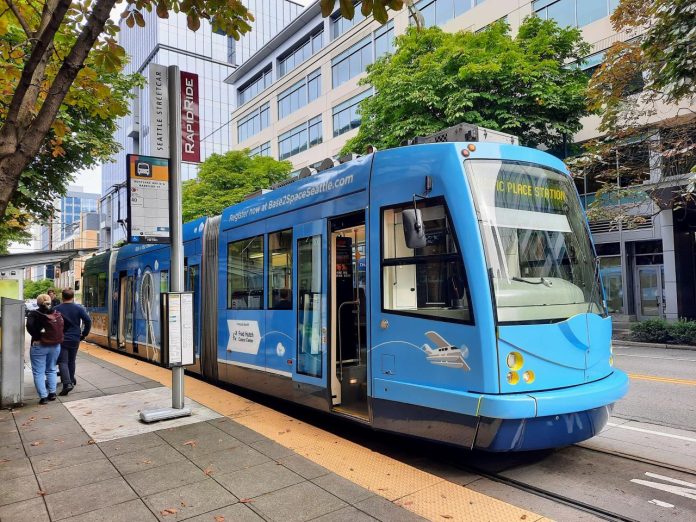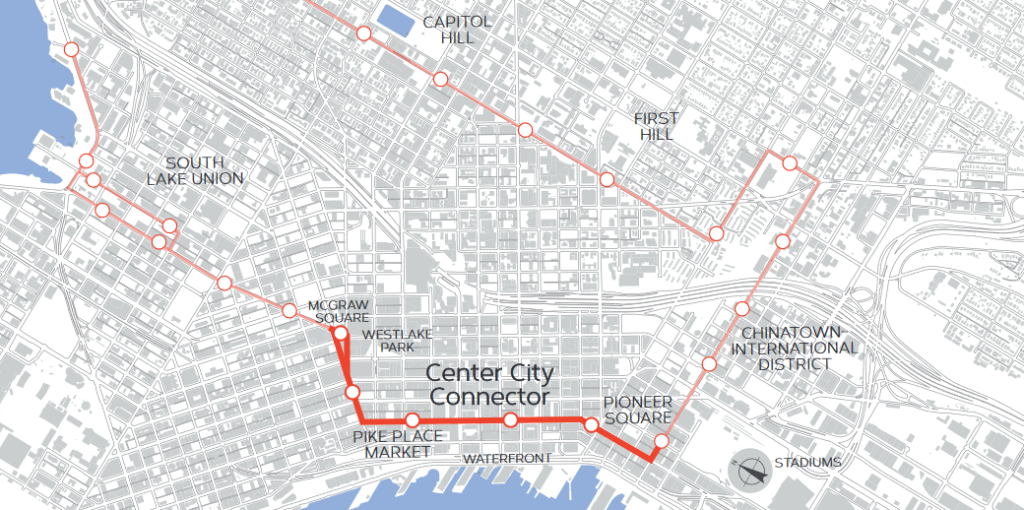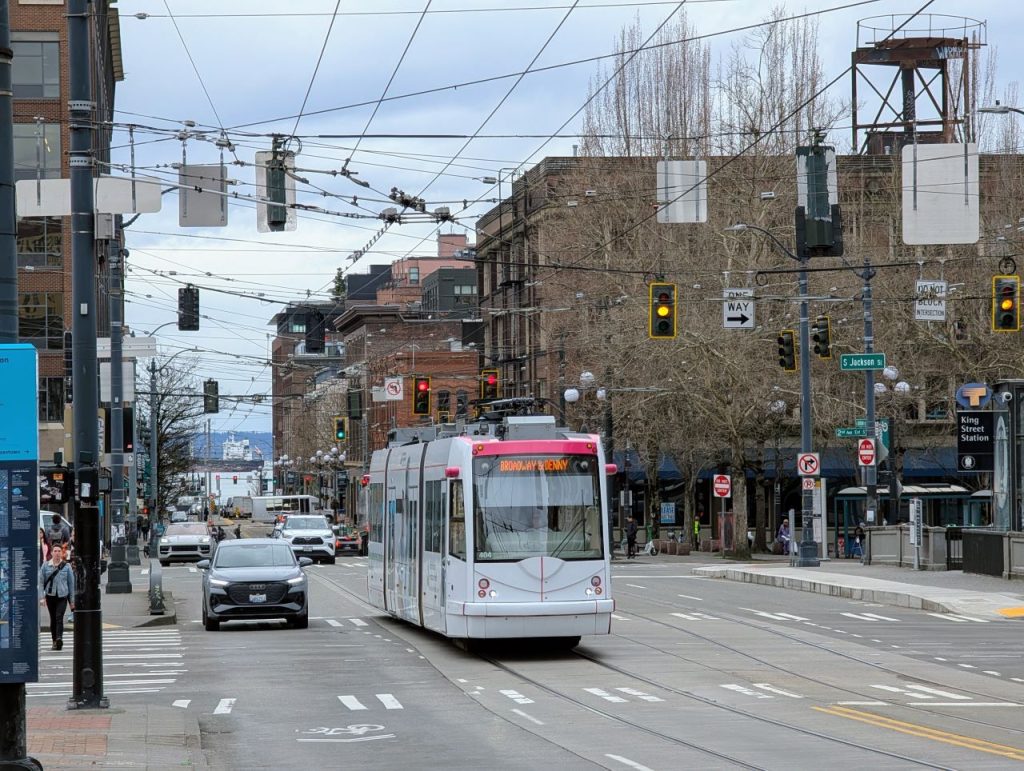
Fares on the two-line Seattle Streetcar system could be going up this year. The Seattle Department of Transportation (SDOT) announced a fare change proposal on March 31, suggesting up to a 75-cent fare increase for regular adult fares in September. The 75-cent hike would increase regular adult fares from $2.25 to $3.00.
The department is proposing to keep fares for ORCA Lift low-income riders and seniors (ages 65 and up) at $1.00. Kids under 18 and under would continue to ride for free, as they do on most transit services in Washington state, thanks to Climate Commitment Act funding.
Regular adult fares on the streetcar lines have been set at $2.25 since 2015. During that time operating costs have risen 52% from $9.1 million in 2015 to an estimated $13.9 million this year. Inflation was about 35% over that timespan. Prior to the 2015 fare change, regular adult fares on the streetcar had been $2.50, but SDOT reduced the rate to match the lowest regular adult fare on the Link light rail system at that time.
Seattle’s streetcar system is facing increasing financial strain, exacerbated by the expiration of financial support from Sound Transit, which helped fund the First Hill streetcar line after abandoning plans for a light rail station in the neighborhood.
Some Seattle councilmembers, led by transportation chair Rob Saka, have pushed to shutter the South Lake Union line as a cost-cutting measure. However, Seattle proponents were able to cobble together five votes to keep the streetcar operating. Nevertheless, in the absence of a commitment to resurrect the shelved Center City Connector streetcar extension and link the two existing orphaned lines, the long-term outlook for the system is bleak.

The 33% fare increase to $3.00 would reduce the amount of operational subsidy that the streetcar will require from the City of Seattle. This may help keep the streetcar off the chopping block in future budget cycles — though there are no guarantees since it only marginally improves the financial picture without the ridership boost the Center City Connector extension was projected to bring.
Unlike King County Metro bus and vanpool services, which are funded primarily by County revenues, streetcar operational funding comes out of City coffers. Metro operates the streetcar lines on behalf of the City of Seattle, provided that the City pays up.
SDOT’s proposal would align streetcar fares with key regional transit partners. Sound Transit charges $3.00 for regular adult fares on Link light rail and ST Express bus services, and King County Metro plans to increase regular adult bus fares to $3.00 in September.
In 2019, the streetcar lines raised $1.8 million in fare revenue (equivalent to $2.3 million in today’s dollars) and in 2023 that number had fallen to $679,000 (equivalent to $706,000 in today’s dollars). SDOT estimates that fare revenue will top $872,000 this year, a far cry from pre-pandemic times. With the proposed fare change, the department is projecting an extra $100,000 to $200,000 in fare revenue going forward, based upon assumptions from 2023 data (fare revenue data from 2024 has not been finalized). However, extension of lower ORCA Lift fares and the restart of fare enforcement could affect those numbers.
Last Monday, Metro restarted fare enforcement on some bus routes as well as the streetcar lines. The agency expects fare enforcement to improve fare payment rates on those services. Metro estimates that over a third of riders are currently skipping out of fare payment on buses and trains, significantly impacting fare revenue across transit services. A 2023 report by SDOT suggests that fare evasion could be even higher on the streetcar system, with as many as 64% of riders failing to pay fares.
Prior to the pandemic and suspension of fare enforcement, Metro had collected over $167 million in fare revenue in 2019 (equivalent to over $200 million in today’s dollars) while the agency only collected $73 million in fare revenue during 2024. Fare enforcement could improve financing for transit service and operations, but ridership also remains down significantly from 2019. Metro’s ridership in spring 2024 was only 64% of 2019 levels.

Ridership on the streetcar lines is still down from pre-pandemic levels, too, but the South Lake Union line continues to struggle the most in the two-line system. At just 1.3 miles long, the South Lake Union line was never meant to be operated without extension over the long-term. (For the matter, the City promised stakeholders the 2.5-mile First Hill Streetcar would be extended through downtown, dangling the hope of boosted ridership to lessen the sting of construction impacts.)
| Yearly Ridership | ||
|---|---|---|
| Line | 2019 | 2023 |
| First Hill | 1,360,035 | 1,175,767 |
| South Lake Union | 503,374 | 236,121 |
| Total | 1,863,409 | 1,411,888 |
| Average Weekday Ridership | ||
|---|---|---|
| Line | 2019 | 2023 |
| First Hill | 4,605 | 3,915 |
| South Lake Union | 1,840 | 560 |
| Total | 6,445 | 4,475 |
In 2023, ridership on the South Lake Union line was still only half what it was in 2019 with 236,121 rides. Conversely, ridership on the First Hill line was at 86.4% of 2019 levels, with over 1.17 million rides.
SDOT said its 2024 data remains incomplete, but preliminary data from Metro shows notable improvements in weekday ridership on the First Hill line, which appear to be continuing into early 2025 and edging toward eclipsing pre-pandemic levels. The picture for the South Lake Union line, however, is more complicated with sporadic ups and downs while remaining persistently below pre-pandemic levels and likely won’t be helped in 2024 data by the temporary shutdown last summer due to equipment issues.
On top of this all, service levels and span of service on both streetcar lines remain somewhat reduced. Peak-hour frequencies are every 12 minutes and off-peak frequencies every 15 minutes, and last service ends around 9:00pm on the South Lake Union line and 10:30pm on the First Hill line on weekdays. Prior to the pandemic, frequencies were better on both lines and service ran later. That ultimately affects potential ridership levels and fare collection.
Barring completion of the Center City Connector extension, the South Lake Union line could be in for a prolonged ridership drought and vulnerable to decommissioning every budget season.
Stephen is a professional urban planner in Puget Sound with a passion for sustainable, livable, and diverse cities. He is especially interested in how policies, regulations, and programs can promote positive outcomes for communities. With stints in great cities like Bellingham and Cork, Stephen currently lives in Seattle. He primarily covers land use and transportation issues and has been with The Urbanist since 2014.

